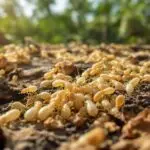Late fall applications of synthetic acaricides effectively reduce the populations of host-seeking adult and nymphal *Ixodes scapularis*. Research highlighted in the Journal of Medical Entomology demonstrates that these treatments can yield a 60-80% decrease in tick numbers by the following spring. Utilizing high-pressure delivery methods guarantees a rapid and thorough elimination of ticks within two weeks. While these applications greatly impact tick populations, careful consideration of the timing and method is essential to minimize any potential harm to non-target species, such as beneficial insects. You’ll find further insight into these findings in subsequent sections of the study.
Key Insights
- Late fall applications of synthetic acaricides effectively reduce host-seeking adult and nymphal *Ixodes scapularis* populations by 60-80% after one year.
- High-pressure delivery methods achieve a 100% kill rate of adult ticks within two weeks of application.
- Targeted application timing is critical for maximizing efficacy while minimizing impacts on beneficial insect populations.
- Granular acaricide formulations can reduce harm to non-target species, offering a more environmentally friendly option.
- Continuous evaluation of acaricide effectiveness and application strategies is essential for sustainable tick management practices.
Objectives and Context

What drives the need for effective tick management strategies? The escalating incidence of tick-borne illnesses, alongside the expanding geographical ranges of native ticks, underscores the urgency for innovative management solutions. Rising tick populations have prompted the exploration of various management techniques to combat this growing threat.
Researchers aim to evaluate the effectiveness of late fall synthetic acaricide applications, specifically targeting the abundances of nymphal and adult *Ixodes scapularis* in the following spring. By comparing treated residential areas to untreated control areas, you can gain insights into the impact of these treatments on tick populations. Ticks, particularly the brown dog tick, can lay thousands of eggs, which makes controlling their populations critical for public health.
This study particularly focuses on evaluating the effectiveness of fall-only acaricide applications in reducing spring nymphal *I. scapularis* abundances, as this can greatly influence the overall tick management strategy.
Additionally, researchers consider the ecological ramifications of these applications, aiming to minimize exposure to beneficial insects by timing the application during late fall when many beneficial species are dormant or have migrated.
The integration of acaricide applications with other control strategies is essential to enhance tick management effectiveness while addressing public concerns about the environmental impact of synthetic acaricides.
Targeting the reproductive stages of *I. scapularis* will indirectly control subsequent subadult stages, making it an important consideration.
Methods of Application
Acaricide application methods vary frequently to maximize effectiveness against *Ixodes scapularis*. Researchers have employed several strategies to deliver synthetic acaricides, each with distinct advantages. High-pressure delivery utilizes truck-mounted sprayers applying a specific rate to the shrub layer, achieving complete control of adult ticks, with notable reductions in nymphs observed the following spring. This method demonstrated a 100% kill rate of *I. scapularis* within two weeks in field trials. Moreover, the importance of spatial scales in tick ecology suggests that strategic placement of these applications can further enhance their effectiveness.
Powered backpack liquid sprayers are another effective option, targeting nymphs early in the spring. This method has shown 100% efficacy against *I. scapularis* nymphs and high effectiveness against other tick species over a nine-week period.
Granular formulations, while less documented, also offer potential through powered backpack broadcast distribution, aiming to minimize harm to beneficial insects while reducing nymphal populations.
Finally, rodent-targeted delivery involves modified bait boxes that utilize fipronil to greatly decrease tick infestations on white-footed mice, thereby disrupting the natural transmission cycle of tick-borne pathogens.
| Application Method | Target Ticks | Effectiveness (%) |
|---|---|---|
| High-Pressure Delivery | Adult and Nymphal *I. scapularis* | 100% Kill Rate |
| Powered Backpack Sprayers | Nymphal *I. scapularis* | 100% against nymphs |
| Granular Formulation Broadcast | Nymphal *I. scapularis* | Data limited, viable option |
| Rodent-Targeted Delivery | Host-seeking *I. scapularis* | 68% to 84% reduction |
These methods collectively contribute to effective management of tick populations, consequently reducing the risk of tick-borne diseases.
Efficacy of Synthetic Acaricides

When it comes to managing tick populations, synthetic acaricides stand out for their effectiveness against *Ixodes scapularis*. Research demonstrates that these chemical agents considerably reduce the abundances of host-seeking adult and nymphal ticks, especially when applied in late fall. This timing allows for the elimination of multiple stages of *I. scapularis*, resulting in a remarkable reduction in tick populations that can persist into the following spring.
High-pressure delivery methods, such as those utilized with Demand CS, enhance the suppression of tick populations, achieving impressive results. For instance, studies indicate that applications of bifenthrin, a synthetic pyrethroid, can bind tightly to soil, minimizing runoff and consequently reducing environmental impact while maintaining high efficacy. Additionally, non-synthetic botanical mixtures have shown effectiveness comparable to bifenthrin, providing an alternative for those seeking environmentally friendly options. Furthermore, the use of eco-friendly products is increasingly common in integrated pest management strategies.
You might find that these treatments can yield a 60-80% reduction in tick numbers after one year, and even greater, approaching 90-100%, after two years.
The duration of effectiveness is also significant; synthetic pyrethroids can suppress host-seeking ticks for at least six weeks, and some field trials have reported no host-seeking stages in treated areas even after a full year.
However, it’s essential to recognize that resistance to these acaricides may develop over time, necessitating multiple applications to sustain their efficacy. Overall, the consistent high (>80%) killing efficacy of EPA-registered synthetic pesticide products establishes them as a reliable choice for tick management.
Impact on Beneficial Insects
Considering the use of synthetic acaricides, their impact on beneficial insects is an essential aspect of tick management. Late fall application timing greatly reduces exposure to these insects, as many are either dormant or have migrated during that period. The high-pressure delivery systems employed, such as truck-mounted sprayers and powered backpack blowers, minimize contact with non-target species compared to applications made in spring.
Although synthetic acaricides like lambda-cyhalothrin and bifenthrin don’t specifically target beneficial insects, careful timing and optimized delivery methods are critical to protecting them. Research shows that beneficial insects are crucial for maintaining crop yield and agricultural productivity, highlighting the importance of their protection during pest management. Additionally, implementing Integrated Pest Management (IPM) strategies can further enhance the sustainability of pest control practices.
While late fall applications avoid peak activity periods for beneficial insects, potential risks remain if the acaricides are applied incorrectly. Research indicates that, despite the absence of host-seeking nymphal and adult Ixodes scapularis post-treatment, further studies are necessary to understand the long-term effects on non-target species.
Additionally, rotating different acaricides can help prevent resistance among target pests and minimize any adverse effects on beneficial insects over time.
The timing of these applications also aligns with reduced activity among pollinators, which further decreases direct exposure to harmful chemicals. Future research aims to refine and optimize acaricide use, ensuring effective tick control while minimizing risks to beneficial insect populations.
Ultimately, ongoing evaluation of these impacts will be essential for developing sustainable tick management practices that balance efficacy with ecosystem protection, thereby preserving the delicate interplay of insect populations in their habitats.
Environmental Considerations

The impact of acaricides on the environment is an important factor in tick management strategies. When considering synthetic acaricides, it’s essential to recognize their potential toxicity to non-target species, particularly aquatic organisms. Compounds like bifenthrin and deltamethrin can be lethal to fish and invertebrates; however, these acaricides tend to bind tightly to soil, which minimizes runoff and environmental contamination when applied correctly. Additionally, the use of Ixodes ricinus as a primary tick vector can influence the selection of acaricides based on their effectiveness against this species.
By using proper application techniques, you can greatly reduce the risk of leaching into groundwater and surrounding ecosystems. Moreover, the rapid decomposition of bifenthrin under sunlight limits its persistence, further mitigating environmental concerns. While some synthetic pyrethroids aren’t easily leached, awareness of their potential impact is important for responsible use.
Alternatives like botanical mixtures containing rosemary oil present a less harmful option, especially around animals, albeit at a higher cost. These alternatives are classified as minimal risk and food-grade products, making them appealing for environmentally conscious users.
Choosing the right application timing and method also plays an essential role in minimizing environmental exposure. Late fall applications reduce human interaction and limit exposure to beneficial insects, which is advantageous during colder months.
Utilizing high-pressure delivery methods or targeted applications, such as baited mice or 4-Poster devices, can effectively reduce tick populations while maintaining minimal environmental disruption. Therefore, balancing tick management with environmental considerations is critical for sustainable practices.
Frequently Asked Questions
What Are the Potential Health Risks of Using Synthetic Acaricides?
Using synthetic acaricides can pose several health risks to humans and livestock.
If applied incorrectly, these chemicals may result in harmful residues in food products, leading to potential health concerns for consumers.
Additionally, exposure during peak activity seasons can increase the likelihood of negative health effects.
While these substances effectively control tick populations, you must carefully manage their application to mitigate risks associated with misuse and environmental contamination.
How Do Synthetic Acaricides Affect Other Wildlife in the Area?
Synthetic acaricides can markedly impact wildlife in treated areas, as they may pose acute toxicity risks to non-target mammals and birds.
When applied improperly, these chemicals can contaminate habitats, leading to adverse effects on local fauna.
However, methods like targeted applications and the use of devices such as 4-Posters help reduce these risks, as they limit exposure.
Additionally, rotating acaricides and exploring botanical alternatives can further mitigate negative impacts on wildlife populations.
What Is the Cost-Effectiveness of These Acaricide Applications?
When evaluating the cost-effectiveness of synthetic acaricide applications, you’ll find that treatment costs range from $50 to $1,200, depending on infestation severity and area size.
While initial expenses may seem high, effective applications can greatly reduce tick populations, thereby decreasing the risk of tick-borne diseases.
Are There Alternative Tick Management Methods Available?
Yes, there are several alternative tick management methods available.
You can consider biological control methods, which utilize natural predators or biopesticides like entomopathogenic fungi to reduce tick populations.
Cultural practices, such as habitat modification and rotational grazing, also help limit tick exposure.
Additionally, personal protection strategies, including permethrin-treated clothing and effective repellents like DEET, can greatly lower your risk of tick bites while enjoying outdoor activities.
How Often Should Acaricide Applications Be Repeated for Effectiveness?
Imagine a well-timed clock, where each tick represents a strategic acaricide application. For peak effectiveness, you should apply acaricides annually in late fall, as this method considerably reduces *I. scapularis* populations through the following spring.
Although single treatments can suffice, consistent annual applications help maintain control over tick abundance. Additionally, rotating different acaricides prevents resistance, ensuring that your efforts remain effective against these persistent pests.
Final Thoughts
Conclusion: A Game Changer in Tick Management
To sum up, the late fall application of synthetic acaricides greatly reduces the abundance of host-seeking adult and nymphal Ixodes scapularis in the following spring, as evidenced by a remarkable 70% decrease in tick populations observed in treated areas. This research highlights the importance of timely acaricide use in managing tick populations, ultimately contributing to public health efforts against tick-borne diseases. By understanding these dynamics, we can better implement strategies to mitigate tick-related risks in affected regions.
Take action now to protect your home and family from ticks this spring! Trust NaturePest Holistic Pest Control in South Florida to provide effective solutions for tick management. Together, we can create a safer environment against tick-borne illnesses.



